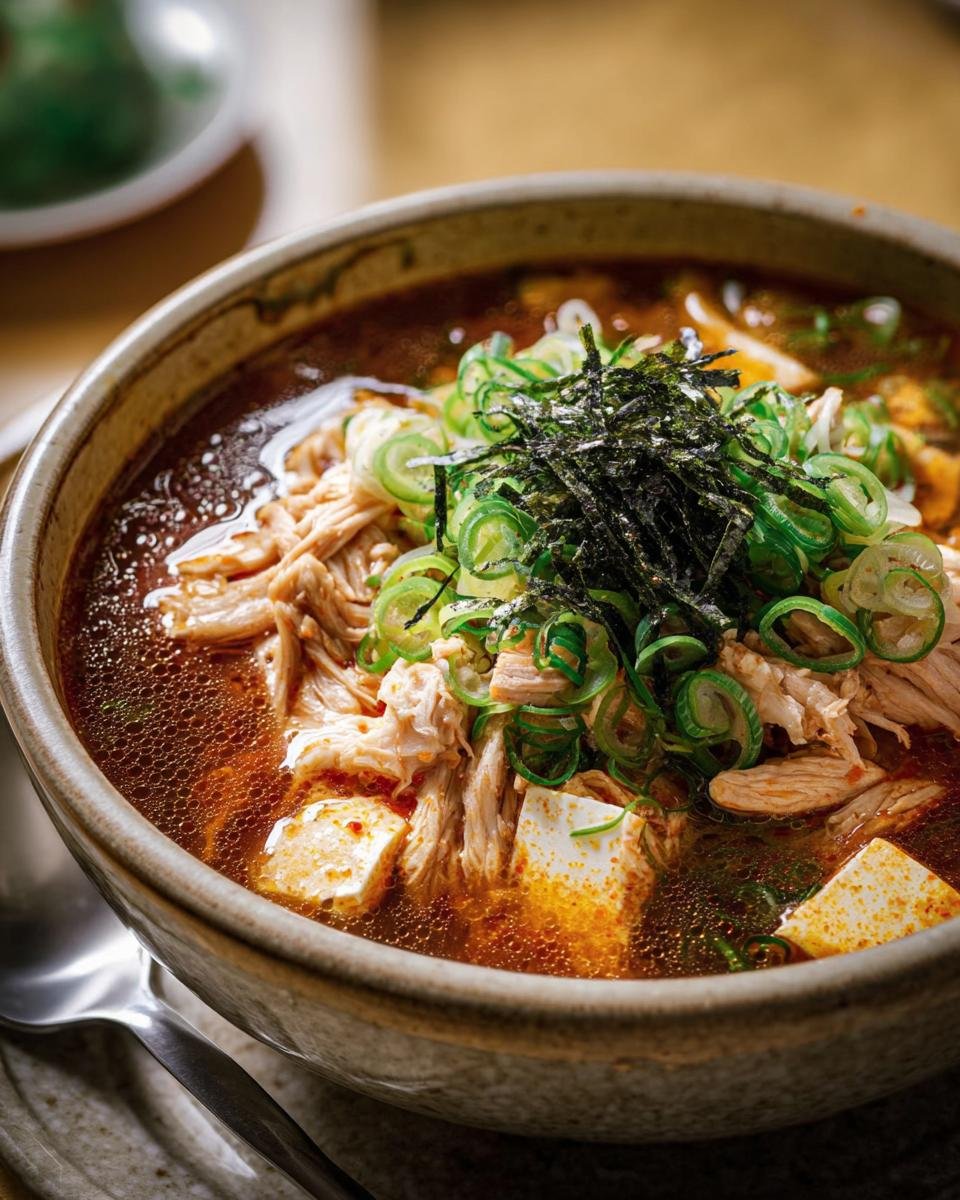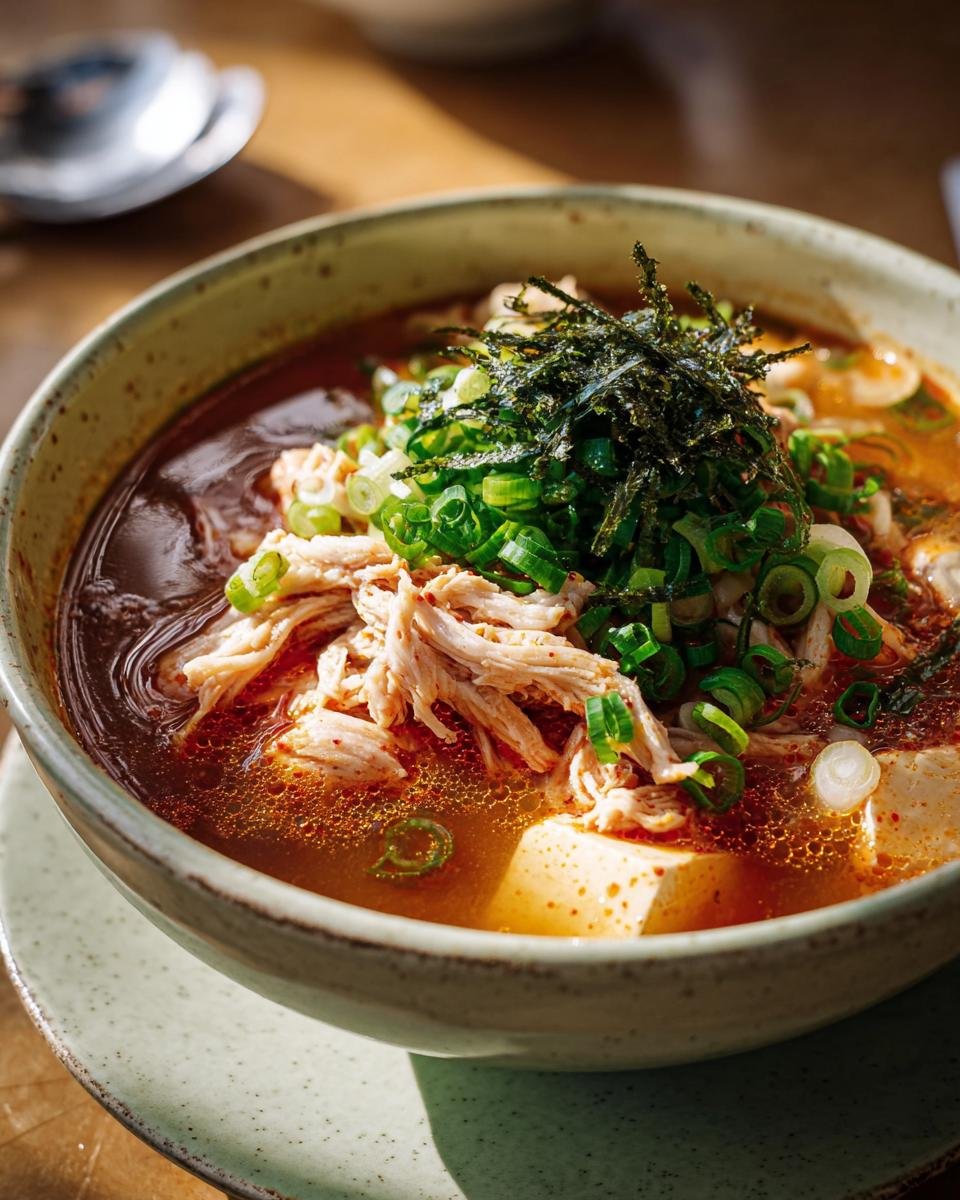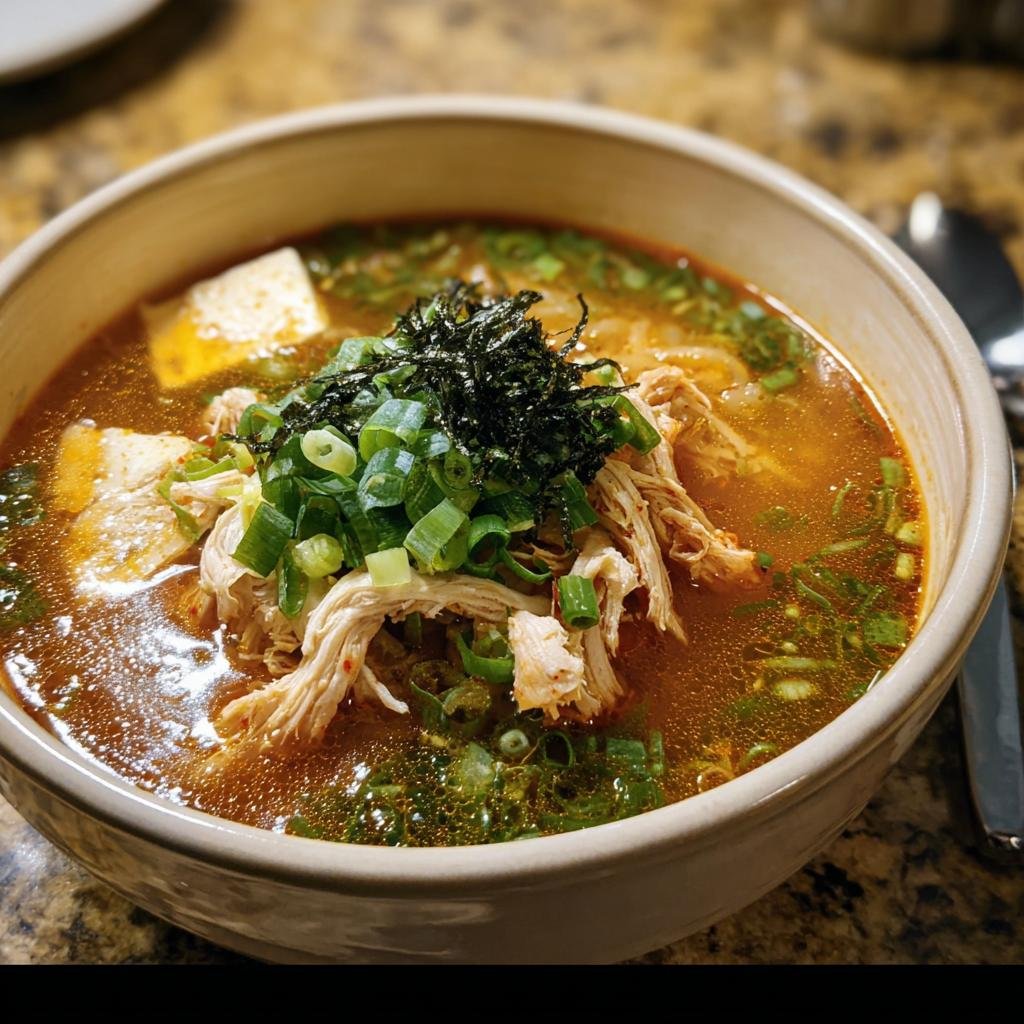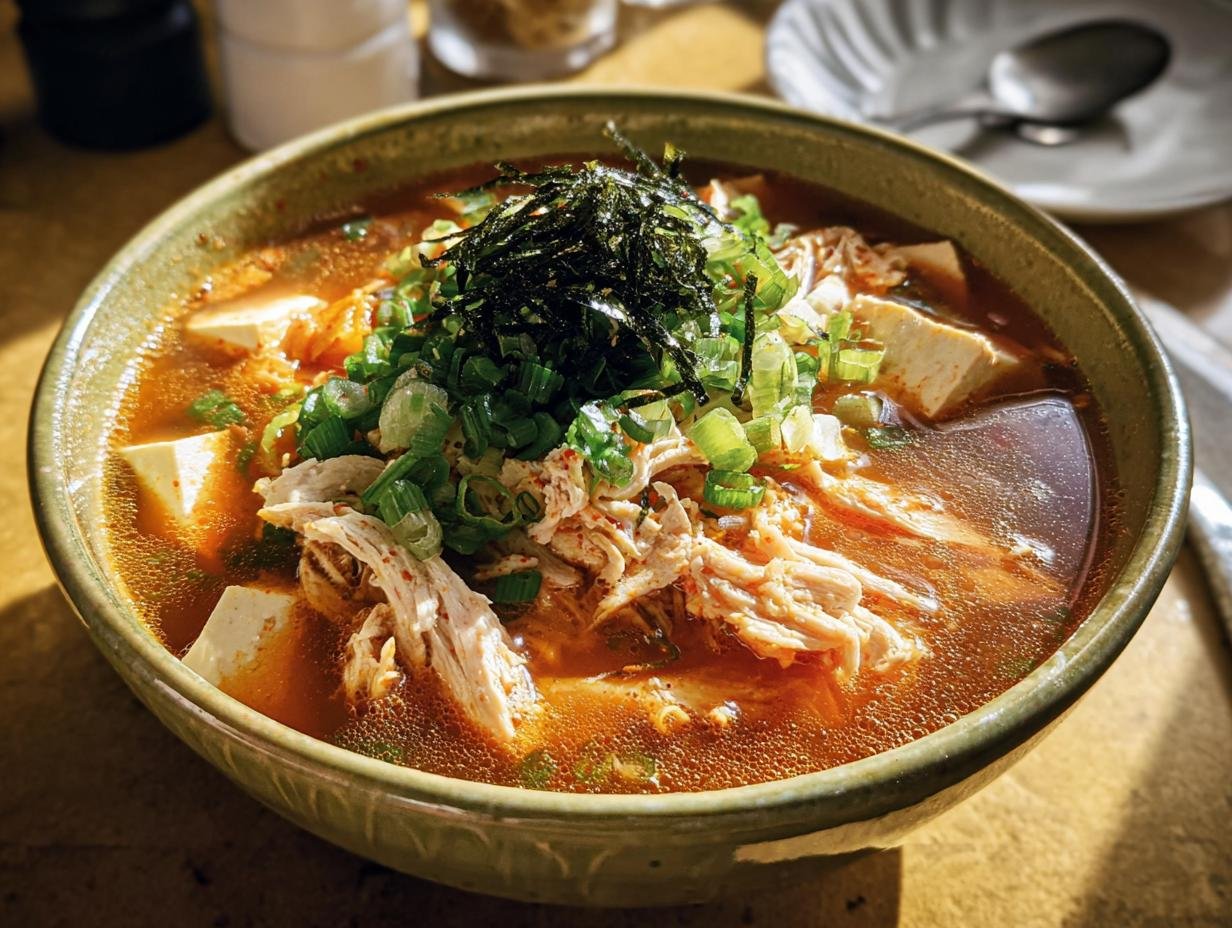Oh, the magic of a steaming bowl of Korean stew! There’s just something so incredibly soul-warming about diving into a pot of bubbling, fragrant broth. When I think about Cozy Korean Soups and Stews, my mind instantly goes to Kimchi Jjigae. I remember the first time I tried it; I was in a tiny little restaurant tucked away in a busy city, and the aroma alone had me hooked. This isn’t just any stew; it’s a flavor explosion – spicy, tangy, a little funky from the fermented kimchi, and oh-so-savory from the pork and the magic of the broth. It’s the kind of dish that hugs you from the inside out, perfect for a chilly evening or honestly, any day you need a pick-me-up. It truly is a quintessential Korean comfort food experience!

Why You’ll Love This Kimchi Jjigae Recipe
Seriously, this Kimchi Jjigae is a total winner, and here’s why you’ll be making it again and again:
- It’s SO easy! You can whip this up in under an hour, making it perfect for a weeknight dinner when you’re craving something hearty and delicious.
- Flavor town, population: you. Get ready for that amazing punch of spicy, savory, and tangy goodness that only well-fermented kimchi can give you.
- Ultimate comfort food. That warm, bubbly stew is like a big hug in a bowl, guaranteed to make even the coldest days better.
- So versatile! You can easily swap out the pork for other proteins or even go vegetarian if you like. It’s a forgiving recipe!

Gathering Your Ingredients for Cozy Korean Soups and Stews
Alright, let’s talk about what you’ll need to get this amazing Kimchi Jjigae bubbling away! You want to grab some good quality, well-fermented kimchi – seriously, the sourer the better for this stew! Overripe kimchi is gold here; it gives that deep, tangy flavor that’s just irreplaceable. This recipe needs about 1 cup of chopped, aged kimchi. Don’t toss that brine either – the kimchi brine (about 1/2 cup will do) is liquid gold and adds so much depth to the broth. I also grab about 150 grams of pork belly, sliced thinly. It renders beautifully and makes the stew so rich and savory. If you don’t have pork belly, thinly sliced pork shoulder works too!
For the texture, we’re going with half a block of firm tofu, sliced up. You want it firm so it holds its shape in the stew. Then, we need our flavor powerhouses: 1 tablespoon of gochugaru (Korean chili flakes – adjust this to your spice preference, trust me!), 1 tablespoon of soy sauce for that umami kick, and 1 teaspoon of minced garlic because, well, garlic makes everything better! We’ll also need about 4 cups of water to get everything simmering.
And for that final flourish? Some optional garnishes that make it extra special: a sliced scallion and some crumbled roasted seaweed. These little touches really elevate the whole experience. Oh, and if you’re looking for more amazing Korean inspired dishes, you HAVE to check out this fantastic Korean spinach side dish – it’s a perfect complement!

Essential Equipment for Your Cozy Korean Soups and Stews
You really don’t need anything fancy to whip up a fantastic pot of Kimchi Jjigae! Just a good medium pot will do the trick for simmering all those delicious flavors together. Of course, you’ll need a sharp knife and a sturdy cutting board to get your kimchi, pork, and tofu prepped. That’s seriously it – simple tools for a ridiculously tasty meal!
Step-by-Step Guide to Making Perfect Kimchi Jjigae
Alright, get ready to make some magic happen! This Kimchi Jjigae recipe is honestly so straightforward, you’ll be wondering why you haven’t made it every week. Here’s how we bring all those amazing flavors together:
- Combine the Good Stuff: In your medium pot, toss in all the delicious base ingredients. That means your chopped kimchi, all that flavorful kimchi brine, the thinly sliced pork belly, your firm tofu slices, the gochugaru (Korean chili flakes), soy sauce, and that fragrant minced garlic. Give it a little stir to get everything acquainted.
- Add the Liquid: Now, pour in your 4 cups of water. We need enough liquid to make sure everything simmers beautifully and the flavors can really meld together.
- Bring to a Boil and Simmer: Pop that pot onto the stove over medium-high heat and bring it all to a rolling boil. Keep an eye on it! Once it’s bubbling away, turn the heat down to medium-low. Pop a lid on the pot and let it simmer away for a good 20 minutes. This is crucial – it allows the pork to get nice and tender and for all those incredible flavors from the kimchi and spices to really deepen and marry.
- Taste and Tweak: After 20 minutes, give it a taste. This is where you become the Kimchi Jjigae master! Does it need a little more salt? More spice? If you like it extra fiery, now’s the time to stir in a bit more gochugaru. Trust your taste buds!
- Garnish and Serve: Ladle that beautiful, bubbling stew into bowls. I love to top mine with some fresh sliced scallions for a little bite and that crumbled roasted seaweed for a touch of salty, oceanic goodness. It just makes it that much prettier and tastier! And hey, if you’re dreaming of more fiery noodle dishes, you absolutely have to try this fiery chicken ramen recipe – it’s sensational!

Tips for Success with Cozy Korean Soups and Stews
Okay, let’s talk about making sure your Kimchi Jjigae is absolutely perfect, every single time! My biggest tip? Seriously, use the oldest, sourest kimchi you can find. That deeply fermented flavor is what gives this stew its incredible punch – fresh kimchi just won’t cut it here. Don’t be shy with that kimchi brine either; it’s packed with flavor and really makes a difference in the broth. When you’re simmering, keep an eye on the consistency. If it looks too thick, just add a splash more water. And tasting and adjusting is key! My favorite part is adding a tiny bit more gochugaru right at the end if I’m feeling brave – it gives it a beautiful color and an extra kick!
Ingredient Notes and Substitutions for Kimchi Jjigae
Let’s chat about the ingredients for this amazing Kimchi Jjigae, because sometimes you just don’t have *exactly* what the recipe calls for, right? First off, the kimchi – I can’t stress this enough, use aged, sour kimchi! If your kimchi is super fresh, it won’t have that deep, tangy flavor that’s the star of the show. If your kimchi isn’t quite there yet, you can sometimes “age” it by leaving it on the counter for a day or two (but watch it closely!).
Now, about the pork belly. It’s my favorite because it gets so tender and adds a wonderful richness. If pork belly isn’t your jam, or you just can’t find it, thinly sliced pork shoulder is a great substitute. Some people even use chicken thighs, cut into small pieces. For the tofu, firm tofu is best because it holds its shape while simmering. If you only have silken tofu, be super gentle when stirring, or add it in right at the very end so it doesn’t break apart too much. If you’re completely out of gochugaru, you could try using a mix of regular chili powder and a tiny pinch of cayenne, but the flavor won’t be quite the same. For another great pork recipe, check out this jalapeno glazed pork tenderloin – it’s fantastic!
Serving and Storing Your Cozy Korean Soups and Stews
This Kimchi Jjigae is practically begging to be served piping hot, right out of the pot! The absolute best way to enjoy it is with a big bowl of fluffy, steamed rice. Seriously, the rice soaks up all that delicious, spicy broth, and it’s pure comfort. If you happen to have any leftovers (which is rare in my house!), just pop them into an airtight container and pop it in the fridge. It’ll keep for about 2-3 days. When you’re ready to reheat, just gently warm it up on the stove or in the microwave. Fun fact: This stew often tastes even better the next day because all those amazing flavors have had more time to meld together even further! Don’t forget to pair it with some roasted potatoes too, like these garlic herb roasted potatoes for a complete meal!
Frequently Asked Questions About Kimchi Jjigae
Got questions about making this hearty Kimchi Jjigae? I’ve got you covered!
Can I make this Kimchi Jjigae vegetarian or vegan?
Absolutely! It’s super easy to make this vegetarian or even vegan. Just skip the pork belly altogether. You can add extra tofu, or even some mushrooms like shiitake or enoki for a nice meaty texture. For a vegan version, just make sure your kimchi doesn’t contain any fish sauce or shrimp paste, which some brands do. You’ll still get tons of flavor from the kimchi itself!
What exactly is kimchi brine and why is it important?
Kimchi brine is just the salty, spicy liquid that accumulates at the bottom of your kimchi jar. Think of it as the concentrated essence of kimchi goodness! It’s packed with all those tangy, fermented flavors. Using it in the stew adds an extra layer of depth and a wonderful sourness that’s crucial for a truly authentic Kimchi Jjigae. Don’t skip it if you can help it!
How spicy is this stew normally? Can I control the heat?
Kimchi Jjigae is traditionally quite spicy, but it also has a wonderful tangy and savory balance. The spice level mainly comes from the gochugaru (Korean chili flakes) and the kimchi itself. You can absolutely control the heat! If you like it milder, start with a smaller amount of gochugaru, maybe just half a tablespoon, and be sure to use kimchi that isn’t super spicy. If you love heat, add more gochugaru or even a pinch of cayenne pepper. Tasting and adjusting is key!
My kimchi isn’t very sour. What should I do?
This is a common one! If your kimchi is fresh or just not super tangy, the stew might taste a bit flat. My best advice is to use the kimchi for a day or two at room temperature before refrigerating it. This helps it ferment a bit more and develop that signature sourness. You can also add a splash of rice vinegar or a tiny bit of extra kimchi brine if you have it on hand. Though, honestly, a truly good Kimchi Jjigae relies on well-fermented kimchi, so it might be worth investing in a jar that’s been aged for a while! For other comforting soup ideas, try this hearty white bean soup recipe!
Nutritional Information Estimate
Because every kitchen and every jar of kimchi is a little different, the exact nutritional info for this Kimchi Jjigae can vary quite a bit! What I can tell you is that it’s wonderfully hearty and satisfying. Think of it as providing plenty of protein from the pork and tofu, healthy fats, and those awesome complex carbs from the kimchi and any rice you serve it with. For a deeper dive into general nutrition, checking out sources on diet and nutrition is always a great idea!

Kimchi Jjigae
Ingredients
Equipment
Method
- In a medium pot, combine the chopped kimchi, kimchi brine, pork belly, tofu, gochugaru, soy sauce, and minced garlic.
- Add the water and bring the mixture to a boil over medium-high heat.
- Once boiling, reduce the heat to medium-low, cover, and simmer for 20 minutes, or until the pork is cooked through and the flavors have melded.
- Taste and adjust seasoning if necessary. If you prefer a spicier stew, add more gochugaru.
- Ladle the kimchi jjigae into bowls. Garnish with sliced scallions and crumbled roasted seaweed, if desired.

